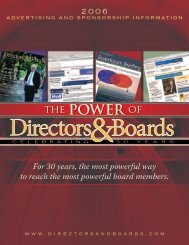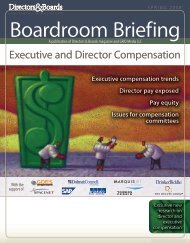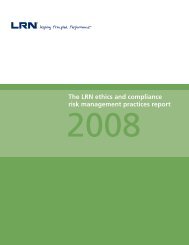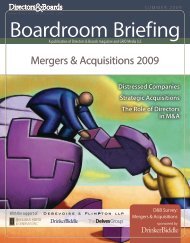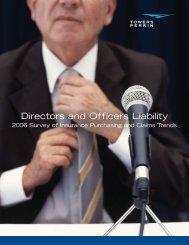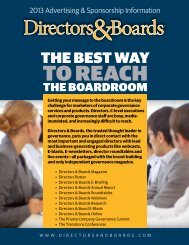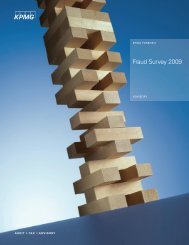Boardroom Briefing: Mergers & Acquisitions - Directors & Boards
Boardroom Briefing: Mergers & Acquisitions - Directors & Boards
Boardroom Briefing: Mergers & Acquisitions - Directors & Boards
You also want an ePaper? Increase the reach of your titles
YUMPU automatically turns print PDFs into web optimized ePapers that Google loves.
Human Capital and M&A<br />
By Graham W. Galloway and Dale E. Jones<br />
12 crucial people questions for directors<br />
During<br />
mergers<br />
and<br />
acquisitions,<br />
boards rightly<br />
focus on the<br />
strategic,<br />
financial and<br />
governance<br />
Graham W. Galloway aspects of a<br />
transaction in<br />
order to further<br />
the goal of<br />
maximizing<br />
shareholder<br />
value. However,<br />
they often<br />
neglect one of<br />
the greatest<br />
sources of<br />
Dale E. Jones<br />
value in<br />
many M&A transactions: the talent<br />
of the management team in the<br />
target company. In our experience,<br />
exercising due diligence about talent<br />
is as important as paying close<br />
Why the neglect of people issues?<br />
During such combinations, boards<br />
largely rely on investment bankers,<br />
who are usually the chief advisors<br />
to the company about the pending<br />
transaction. Understandably, bankers<br />
focus on the financial aspects of the<br />
deal. Addressing the people issues<br />
comes much later in the process,<br />
if at all. Management, too, often<br />
underestimates the value that can<br />
easily be destroyed by some of the<br />
most common practices in post-<br />
M&A staffing.<br />
For example, in straight acquisitions<br />
a winner-take-all mentality often<br />
prevails. Executives of the acquiring<br />
company simply keep most of the top<br />
jobs in the post-merger organization<br />
and little effort is made to retain<br />
the next tier of executives in the<br />
acquired company. Yet it is the talent<br />
of those executives that made the<br />
acquired company a desirable target<br />
in the first place. In service-based<br />
Even in mergers where a genuine<br />
integration of the two companies is<br />
intended, the value of talent often<br />
gets less careful consideration than<br />
it should. For example, when one of<br />
the merging companies is larger than<br />
the other, the smaller may demand<br />
some key positions in the post-merger<br />
organization as part of the negotiation<br />
of the deal. Instead of genuinely<br />
assessing the talent of the two<br />
companies to make sure that positions<br />
are filled by the best available person,<br />
the parties simply divvy up the<br />
positions as part of the transaction<br />
agreement. In addition, the mid-level<br />
executives from the lesser partner<br />
who stay with the organization,<br />
knowing that no real assessment of<br />
talent has taken place, may doubt<br />
their chances of succeeding in the<br />
new company, become demotivated,<br />
and eventually leave.<br />
There is a strategic promise behind<br />
every acquisition—and leadership<br />
Even in mergers where a genuine integration of the two companies is intended,<br />
the value of talent often gets less careful consideration than it should.<br />
attention to the balance sheet, cash<br />
flow and expected synergies of a<br />
deal. By asking management a series<br />
of questions about human capital in<br />
a merger or acquisition, boards can<br />
contribute to a smoother transition to<br />
a single company, a better merging<br />
of cultures, the loss of fewer “A”<br />
players, and a stronger talent bench<br />
for the merged company—all of<br />
which should ultimately create more<br />
value from the deal.<br />
companies, certainly human capital<br />
delivers the value. But even in a less<br />
obvious example, such as a patentbased<br />
acquisition, much of the value<br />
in the acquired company has been<br />
created by people who contributed<br />
to the technology that leveraged the<br />
patent estate. In both cases, simply<br />
allowing that talent to walk out the<br />
door increases the likelihood that<br />
the acquirer will be getting a less<br />
valuable asset.<br />
has to be able to deliver on that<br />
promise. Defining what kind of<br />
leadership is required and selecting<br />
and deploying those leaders in the<br />
right leadership teams is essential.<br />
While M&A transactions can vary<br />
greatly and some of the human capital<br />
considerations discussed here may<br />
not apply, in most cases there is a key<br />
question that boards should always<br />
ask: “What are we doing to determine<br />
our leadership requirements and to<br />
1 8 B o a r d r o o m B r i e f i n g : M e r g e r s & A c q u i s i t i o n s


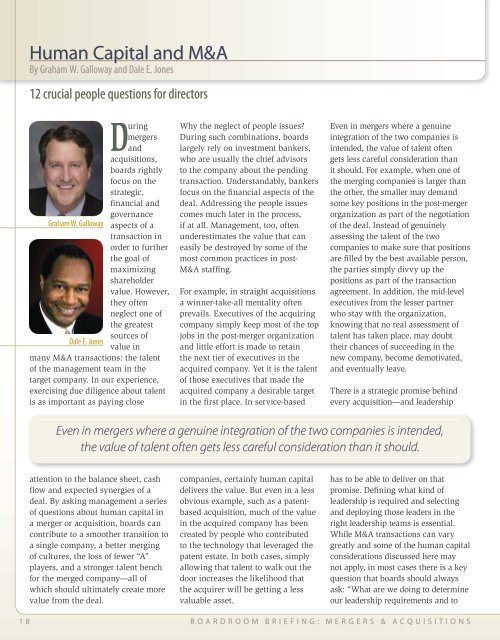
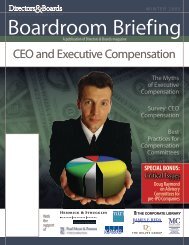
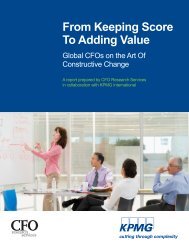
![[link to PDF] for a copy of the briefing paper - Directors & Boards](https://img.yumpu.com/43729022/1/190x245/link-to-pdf-for-a-copy-of-the-briefing-paper-directors-boards.jpg?quality=85)
